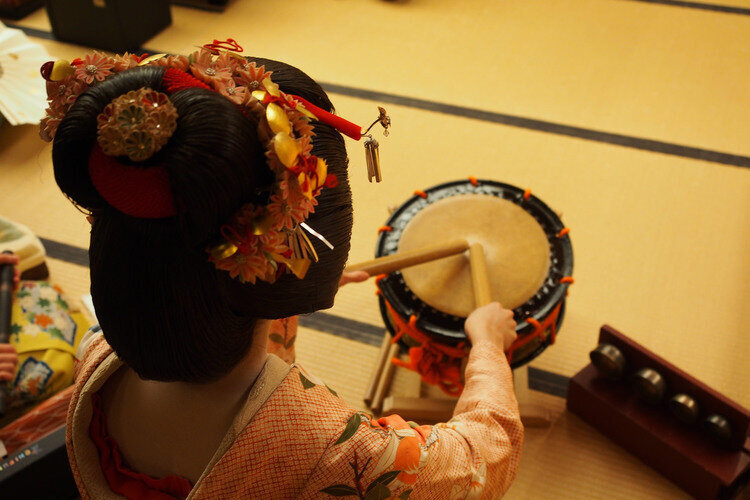Tokyo's Hidden Geisha Culture
GEISHA culture IN TOKYO
When one thinks of Japanese geisha, images of beautifully dressed maiko hurrying through Kyoto’s Gion District usually come to mind. However many people are unaware of the impressive hanamachi (Japanese geisha districts) and rich geisha culture that is alive in Tokyo. Due to its obscurity, geisha culture in Tokyo is dwindling and could soon be lost. Geishas are less prevalent in modern times compared to the past, yet they continue to fulfill their traditional roles in Japanese society. Encountering a geisha in Japan is a rare experience, but not entirely out of reach. They partake in exclusive dinners and entertain loyal clients in geisha tea houses. The secretive world of Tokyo’s geisha culture is one of hospitality, dedication, and years of history; to witness it is incomparable to anything else. Shimbashi, Asakusa, Yoshicho, Kagurazaka, Akasaka, and Mukojima are Tokyo’s six hanamachi, known collectively as ‘Tokyo Roku Hanamachi’ (The Six Flower Towns), and we would like to briefly explain a bit about some of these areas.
In these districts, geishas, translating to "art persons" in Japanese, showcase their mastery in singing, dancing, playing traditional instruments like the samisen, and engaging in the art of conversation. Many geishas in Tokyo further hone their skills in ancillary arts such as flower arranging, conducting tea ceremonies, and calligraphy, making each hanamachi a unique and culturally rich enclave worth exploring. You can learn more about the LIFE OF A GEISHA here.
Geisha or Geiko?
Before we introduce a few of the remaining hanamachi in Tokyo, we would like to first clarify a difference in terminology that even some Japanese locals confuse. The term geisha is a term that has become familiar around the world as a symbol of Japanese culture, and geisha can be found all over Japan - except in Kyoto. In Kyoto, geisha are referred to as geiko. On the other hand, the term used for those training to become a geisha or geiko is maiko (explained in one of our previous articles, The Life of a Geisha), which is the same throughout Japan. So next time you’re visiting Kyoto, remember that there aren’t any geisha, only geiko and maiko.
Asakusa is home to Sensoji Temple and close to Sky Tree ©TOKI
ASAKUSA
Highly regarded, Asakusa stands out among other areas in Tokyo, not only for its geisha population but for the distinct feeling of stepping into the past it brings with it. Its abundance of Japanese culture goes hand in hand with its authentic geisha culture, bringing the past to life in front of one’s eyes. Walking down the charming, Edo-style Kannonura Street, the sounds of shamisen (三味線, a three-stringed traditional Japanese instrument) being played can be heard and if you’re lucky, you might catch a glimpse of geisha entering hidden traditional tea houses in the evening.
YOSHICHO
Yoshicho, also known as Nihonbashi Yoshicho, is considered the most elegant geisha district in Tokyo. Situated in the heart of the city, it is home to dozens of geisha and is eminently popular among the high class of Japan. The traditional music played by the geisha of Yoshicho, along with the poems they recite, are said to be invaluable. One of the few hanamachi still prosperous and thriving, already setting it apart from the others, it also welcomes foreigners to witness geisha performances, unlike most other districts.
KAGURAZAKA
Kagurazaka was Tokyo’s original hanamachi, located on the edge of what used to be Edo Castle. Rich with Japanese history, it is home to some of the only surviving traditional geisha houses from the Edo period left. A sublime blend of historic and modern, its tiny alleys hide elegant, traditional restaurants. Adorned in beautiful, colorful kimono, geisha can be found captivating clients with their music and dancing inside these clandestine restaurants in the evenings. Even rarer, one can enjoy the company of a taikomochi (太鼓持, the original male geisha) in Kagurazaka. With only five left in all of Japan, it is truly a remarkable and unique Tokyo geisha experience.
Akasaka lies in Minato-ku, where you’ll find Tokyo Tower ©TOKI
Akasaka
The Akasaka hanamachi is located in the heart of Tokyo’s Minato Ward. While it wasn’t recognized as a hanamachi during the Edo period, it officially became home to geisha in 1868 (Meiji period) and was ranked as one of the 25 hanamachi in Tokyo at the time. By 1906 there were 18 geisha houses, and by 1955 there were 300 geisha and 80 ryoutei Japanese-style restaurants where they entertained guests. It has since dwindled in size after the economic bubble burst, however even today it maintains its prestige and sophisticated atmosphere, entertaining bureaucrats and corporate executives who work in the surrounding government district.
We hope that you learned a little bit about Tokyo’s geisha culture through this article. If you would like to know more about HOW TO PARTICIPATE IN GEISHA DINNER or THE HISTORY OF GEISHA IN JAPANESE CULTURE, check out our articles in the links below, and if you would like to experience this cultural hidden gem, check out our Geisha Entertainment experience.
RELATED EXPERIENCES
RELATED ARTICLES






